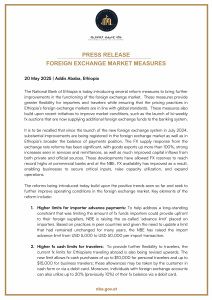11 August 2023 | Addis Ababa , Ethiopia
The Board of Directors of the National Bank of Ethiopia, at its regular meeting of August 7, 2023, has taken a number of policy measures to help reduce inflation in a significant and sustained manner. These measures are effective as of today.
Background
Inflation has been one of the most difficult macroeconomic challenges facing Ethiopia over a period of many years. The Ethiopian economy and population have lived with inflation for a very long time, as seen from the average inflation rate of 16 percent per year registered over the past decade. Inflation outturns over the past two years have risen even beyond this average historical rate and persisted for much longer than initially expected.
High inflation is damaging from both a macroeconomic perspective and from its negative impacts on the livelihoods of millions of ordinary Ethiopians. Inflation reduces the real income of those on fixed salaries and hurts the most vulnerable in society. Moreover, the longer inflation is allowed to persist, the greater the likelihood that it becomes entrenched and the more difficult in becomes to shift public expectations regarding future inflation.
Recent Inflation Outturns
Ethiopia’s latest inflation outturn as of June 2023 shows a year-on-year headline inflation rate of 29.3 percent, which has brought inflation to below 30 percent for the first time in two years. Inflation is now about 5 percentage points below the 34 percent inflation rate of a year ago (June 2022) and is also notably below the peak inflation rate of 37 percent seen in recent years. While there has thus been some modest progress, this is clearly not enough.
Food inflation, for example, is down 10 percentage points over the past year (now 28% vs 38% a year ago) but nonetheless remains high. Non-food inflation has trended upwards in recent months and is 3 percentage points higher now (31%) than it was a year ago (28%). In addition, the inflation rate seen on a monthly basis shows prices were 3.3 percent higher in June 2023 compared to May 2023, pointing to continued inflationary pressures within the economy.
Underlying Inflation Determinants and the Near-term Outlook
Various studies undertaken within NBE and elsewhere have found that a mix of supply-side constraints, cost-push factors, inflation expectations/inertia, and macroeconomic policies have been important—to different degrees and at different points in time—in explaining Ethiopia’s inflation. Using latest data available to June 2023, NBE has recently undertaken a detailed empirical assessment of inflation’s underlying determinants and found that the combined impact of supply-side factors, cost-push factors (including external shocks), and expansionary fiscal/monetary policy helps explain the surge in Ethiopia’s recent inflation.
For example, some supply-side and cost-push factors found to be statistically significant in contributing to inflation have included the internal conflict that disrupted local food transport/distribution networks and the large jump in key global commodity prices (particularly for fuel, fertilizers, and freight). To take the impact of external price effects alone, between mid-2020 and mid-2022, global oil prices rose by 140%, fertilizer prices rose by close to 200%, and freight prices by around 300%; these global prices have all since moderated as of mid-2023, but their pass-through effects for Ethiopian inflation were particularly pronounced in both FY 2021-22 and FY 2022-23.
At the same time, given the succession of shocks Ethiopia faced in the last few years, fiscal and monetary policies have been relaxed during this period to help address and respond to the varied range of internal and external shocks. This has not helped in the battle against inflation, even if the looser stance of macro policies has not been the exclusive driver of Ethiopia’s inflation outturns during this period.
Looking ahead, current global and domestic conditions present a very mixed picture for the inflation outlook. Some reduction in food price pressures is possible from the very good rainy season being experienced in most parts of the country, from the moderating headline inflation trend in most trading partners, and from the sharp year-on-year price decline seen for certain global commodities such as fertilizers. At the same time, Ethiopia’s recent pattern of month-on-month price increases does not suggest a slowdown in inflationary pressures and global prices for some commodities such as oil and cereal grains have trended back upwards in the last few months after having declined earlier in the year. On balance, the near-term outlook is thus best viewed as an environment where inflation risks are still considerable and where the policy stance needs to be appropriately cautious and restrained to ensure a significant and sustained drop in inflation.
Towards a Lasting Solution: A Need for Coordinated Efforts
With multiple contributors to inflation, the long-term solution to Ethiopia’s inflation problem must necessarily involve coordinated efforts in multiple areas and among multiple stakeholders:
- Supply-side measures to improve food production and productivity remain particularly critical given the still dominant role of food prices, which make up 54 percent of the CPI index. In this respect, wide-ranging efforts taken to expand acreage cultivated, to increase irrigation, to encourage cluster farming, to broaden farm mechanization, to initiate low-land farming, and to accelerate the planting of widely consumed crops (wheat, fruits, vegetables) are particularly significant and must to be continued. Other supply-side initiatives to boost output in other key goods and services will also be equally vital, especially in areas such as cement, housing, household supplies, and transport services.
- Structural measures to improve transport networks, logistics systems, and the competitiveness of retail/wholesale trade will also be important. Especially over the long-term, these measures are necessary to make supply chains more efficient and product markets more competitive—all of which should moderate future price pressures.
- Fiscal policy will also need to play a strongly supportive role alongside the supply-side and structural measures outlined above. Ethiopia’s fiscal challenges have been particularly severe over the last two years as a series of shocks (COVID, conflict, drought) called for exceptional spending measures while also lowering revenue growth. Budget deficits have thus risen and, with limited external funding, most of the deficit financing has had to be sourced from domestic sources, especially from the NBE. For the year ahead, however, the Government has taken a very disciplined stance of limiting the budget deficit in order to restore macroeconomic stability and help reduce inflation. Expenditure growth has been restrained and the budget deficit is being reduced—relative to GDP—for the current 2023-24 fiscal year. This will lower Government’s financing needs from the domestic banking system—and importantly from the NBE.
The Unique Role of NBE
With respect to NBE, its contribution to the various inflation reduction efforts outlined above will be equally indispensable—and especially so over the short-term. In recognition of this, the Board and Management of NBE have assigned a very high priority to addressing inflation in a firm and convincing manner this fiscal year. Following extensive internal analysis, and recognizing that the significant credit expansion of the past year has undermined progress in reducing inflation, the NBE has taken the decision to put in place limits on credit growth for this fiscal year—both in credit to the government and in credit to the private sector. We have accordingly put together a comprehensive package of measures aimed at reducing inflation as outlined below:
- As an overall target, NBE will be working towards reducing inflation to below 20 percent by June 2024 and below 10 percent by June 2025.
- For this fiscal year ending June 30, 2024, credit growth is to be limited to 14 percent, and all commercial banks will be instructed to limit the growth of their loan books to be consistent with this aggregate credit ceiling;
- NBE is to sharply reduce Direct Advances to the Government this fiscal year and limit such lending to just one-third of the prior-year levels. Understandings are also to be reached with the Ministry of Finance to make use of this facility only as a last resort if sufficient Treasury Bills and Treasury Bonds cannot be raised in the market;
- The interest rate at the NBE’s Emergency Lending facility, which banks utilize when they face liquidity problems, will be increased from 16% to 18%;
- In addition, to promote a recovery in exports—particularly for manufactured exporters—the foreign exchange surrender requirement is also being reduced. Accordingly, a New Directive is being released whereby exporters of goods and services will surrender 50% of their foreign exchange proceeds to the NBE, 10% to their bank, and retain 40% for their own account.
Conclusion
Three aspects of the monetary policy measures being taken today are worth highlighting to ensure stakeholders understand their proper context and significance. First, these measures are slowing down credit growth but not eliminating it. Second, the decision to lower credit growth is not being taken as an end in itself, but should be seen instead as an important and necessary part of our ultimate collective objective to reduce Ethiopia’s inflation rate in a sustained manner. Third, the use of credit ceilings is a temporary arrangement to be used until mid-2024 when the NBE expects to move towards a more modern, interest-rate based monetary policy framework that will be introduced with extensive preparatory work and with the involvement of all stakeholders.
In conclusion, with a strengthened focus on its core mandate of ensuring price stability, NBE stands determined—alongside other stakeholders—to achieving a major inflation reduction in both the current and upcoming fiscal year, so that this long-standing burden faced by all Ethiopians is meaningfully and sustainably addressed in the period ahead.



